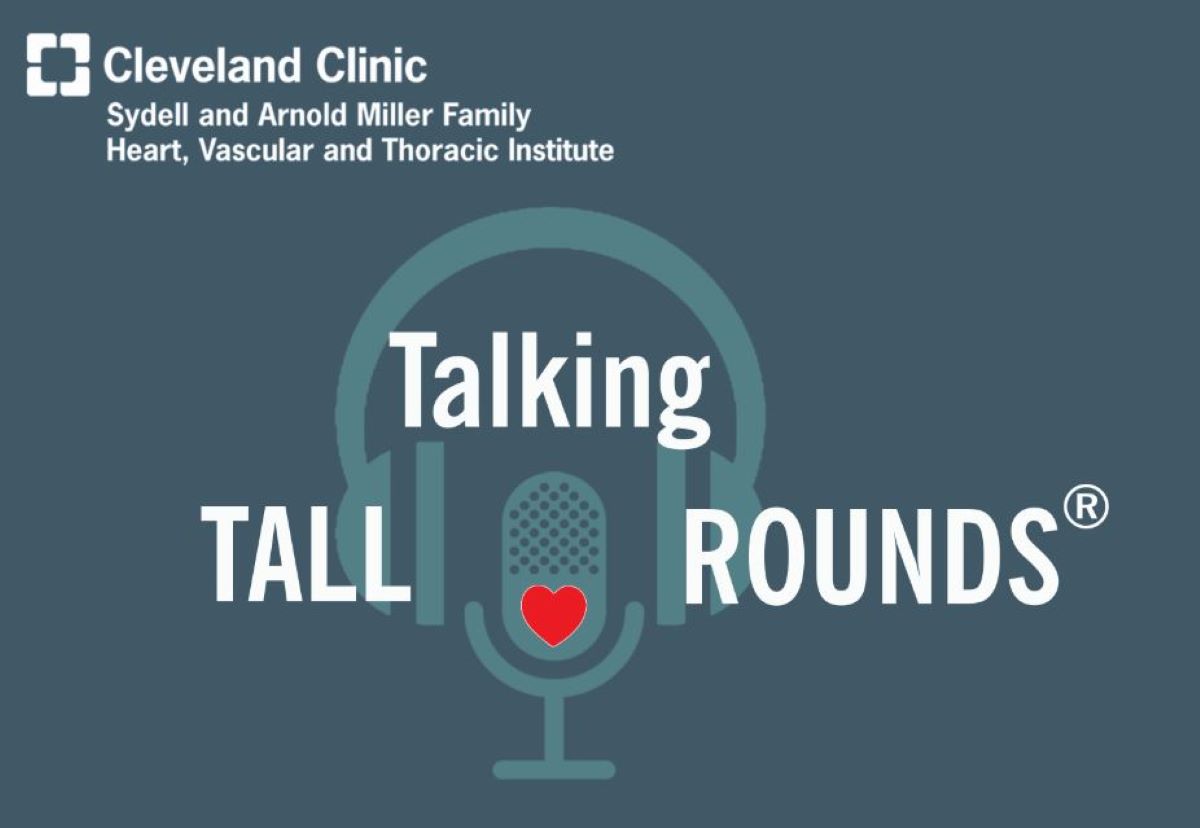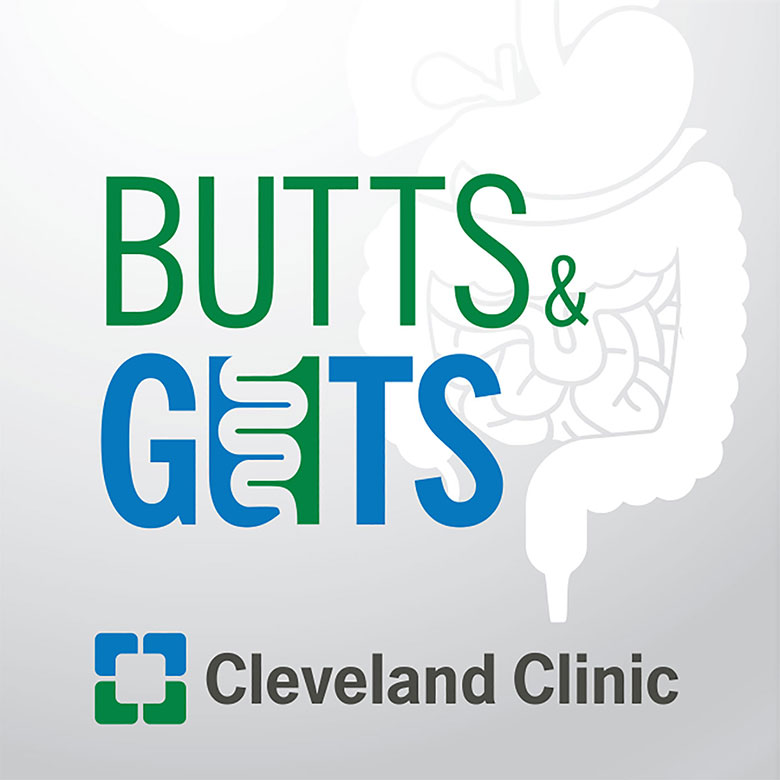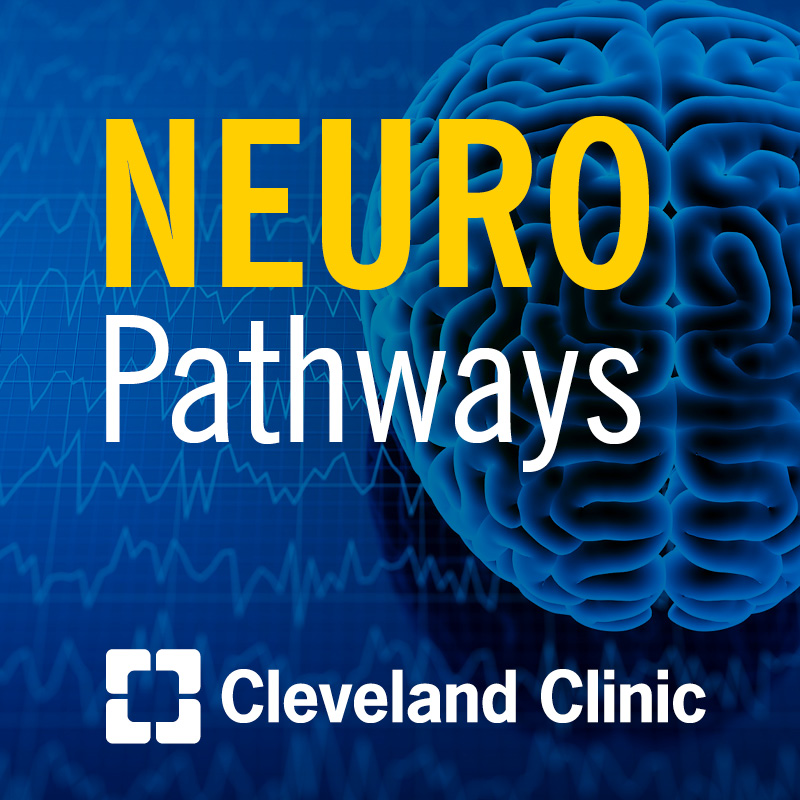Talking Tall Rounds: Multivalvular Rheumatic Valve Disease

Ben Alencherry, MD, presents a case and the pathophysiology of rheumatic heart disease, and Amar Krishnaswamy, MD, Section Head of Invasive and Interventional Cardiology in the Robert and Suzanne Tomisch Department of Cardiovascular Medicine, discusses the TAVR experience at Cleveland Clinic.
Subscribe: Apple Podcasts | Podcast Addict | Buzzsprout | Spotify
Talking Tall Rounds: Multivalvular Rheumatic Valve Disease
Podcast Transcript
Announcer:
Welcome to the Talking Tall Rounds series, brought to you by the Sydell and Arnold Miller Family Heart, Vascular and Thoracic Institute at Cleveland Clinic.
Ben Alencherry, MD:
I want to jump into the patient case. So, the patient we'll present as a 63-year-old male, has a past medical history of rheumatic heart disease with mitral and aortic involvement, has coronary artery disease. He suffered a left anterior descending artery STEMI in 2016 and was revascularized and has subsequently heart failure with reduced ejection fraction after that event and he now presents with dyspnea on exertion. So, to bring up these salient points, this gentleman was born in India, immigrated in his late 20s to the United States. He has known about his valvular disease for the last 10 years, but it has not been any sort of problem. He has exercised regularly and now over the last two to three years he has had, what he and his wife describe as, just slow onset of dyspnea on exertion. So, he previously exercised regularly and now he has some limitation at peak exercise. He has no other significant medical history, and he has no knowledge of any acute rheumatic fever episodes when he was younger or strep throat infections. And just to give a timeline, showing that once he knew about his valvular disease, he was still rather asymptomatic for about 10 years.
So, he was approached by his physicians from out of state and they said that he would be a surgical candidate and that he should go for open heart surgery. And he came to the Cleveland Clinic just for an option to understand, are there any transcatheter valvular interventions that can be done on both valves? This would be a rather novel approach, rarely if ever, described in the literature to do both at the same time to address both the aortic valve and mitral valve. And so, he ended up coming here for consultation. We will review all of the imaging data and there's no surprise at the end, he ended up getting a transcatheter intervention, so you'll know that. So, as we review the images, that's something to keep in mind.
So first to review his EKG. Notable, I think is rheumatic heart disease patients, he is in sinus rhythm. He otherwise has a relatively normal ECG except for signs that he had a past infarction in the anterior precordium here with Q waves throughout V1 to V6. Otherwise relatively normal EKG. And now his transthoracic echocardiogram, so this is a parasternal long axis on the left. I want you to focus on the mitral and aortic valves here. And you see that the mitral valve is thickened, somewhat calcified here. And you have inflow convergence here suggestive of mitral stenosis and you can see there's some mitral regurgitation. Around the aortic valve as well, it is thickened, it is not normal and you have some aortic regurgitation as well as an outflow, flow convergence suggestive of aortic stenosis. Just to show that he did suffer some residual damage from his LAD STEMI here. He has an apical wall motion abnormality in that territory. And you see again, the mitral valve has a restricted opening.
So now our classic short axis view of the mitral valve. I wanted to highlight for you the lateral commissure here and how it is not normal in its opening, there's a fused commissure. We don't catch the media commissure too well here, but there was some involvement there that we'll go over. And on your right is the doppler inflow profile, showing a very typical mitral stenotic profile. Now mind you, he is in sinus rhythm at a heart rate of 55 and he is mounting a gradient of 8 for his mean gradient. So, you can imagine how symptomatic this patient would be.
Now turning our attention to the aortic valve, this is a trileaflet aortic valve. The morphology is a bit unique here because we are seeing that in the commissures in between the right and non and right and left coronary cusp, you have calcification there and we have a CT later to kind of show this a bit better. The long axis view of the aortic valve again shows the abnormal thickening, and we have a color image here, that again shows that there's turbulence throughout systole, consistent with aortic stenosis.
And here are the hemodynamic profiles of the aortic valve. So, his Vmax was 4.1 meters per second. His dimensionless index was around 0.2, consistent with severe aortic stenosis and he has probably moderate aortic regurgitation. So altogether, he has mixed mitral disease with severe mitral stenosis and probably mild to moderate mitral regurgitation. He has severe aortic stenosis with moderate aortic regurgitation. We then performed a TEE, which is important in this case for setting up, if he is a transcatheter candidate. The left atrial appendage had no thrombus in it, and we were able to get a 3D view of the mitral valve for an accurate valve area of around 1.5. While doing the TEE, it offered us a chance to look at the aortic valve a bit closer for any sort of transcatheter assessment. And you see here that this is a tricuspid aortic valve, and you have commissural involvement in those areas that I noted and note that the rest of the leaflets are relatively spared.
So as part of the TAVI workup, he then received a 4D CT and I'll show some of these images because sometimes it gives us a chance to look again at that mitral valve anatomy. So, a short axis view here, where you'll see a bit of calcium here and some fusion of the lateral commissure. And I've made this as an echo view of the anterior of a two-chamber view. And you again see the wall motion abnormality in the LED territory, and this is a four-chamber view showing the same.
Now turning our attention to the aortic valve here, and this view is particularly important, especially in CT, to highlight where the calcification is, and you can see that it is not like our degenerative aortic stenosis patients. Perhaps the majority of the calcification is at the commissure, as opposed to at the base of the leaflets. We got an AVA of around 1.1 based on CT. So now I want to take the time to talk a little bit about the pathophysiology and epidemiology of rheumatic.
Brian Griffin, MD:
Sorry, Ben, just before you go on there, just to put this case in context. So, this is a gentleman who has pretty significant mitral and aortic stenosis, relatively uncommon actually, mostly when you have rheumatic disease, it's aortic regurgitation. So, this is actually kind of interesting. Of course, you can get aortic stenosis with rheumatic disease, but this is kind of disproportionate. And he had coronary disease, makes you wonder if it's kind of a combination of degenerative thickening of the aortic valve on top of rheumatic disease. But you presented beautiful pictures and they're pretty compelling. So, we will be very interested to hear what people want to do with it.
Ben Alencherry, MD:
I think that's a great point. I'll touch on this, the constellation of valvular involvement in this case. So first a few terms that we should all be familiar with, going back to medical school and also if you have kids. So strep infection, that is the start of this disease. So, you could imagine, you go to school, you get a strep throat infection, highly contagious, all the parents get emails. So, imagine now in the overcrowded population, where you have 10 people living in a household, if one person gets a strep infection, this goes around the house. So, the way this disease starts is, group A streptococcus typically causes pharyngitis housed in the posterior oropharynx. It can also be involved in skin and soft tissue infections, but we think the main implication here is in the posterior oropharynx. So, you have a strep infection, and you may or may not get treated. Around 50 percent of patients with strep pharyngitis don't even know they have it. So, you may or may not get treated.
Now, some components of these patients then develop acute rheumatic fever. So, the first term is group A strep infection. The second one is acute rheumatic fever, which is a separate entity altogether. This is typically seen in patients 5 to 15 years old, and you can think of it as a systemic inflammatory response that involves many different things. We learned about the Jones criteria, but I want to focus on the pancarditis that can evolve in this. When we talk about chronic rheumatic heart disease, it is different from the pancarditis that evolves with acute rheumatic fever, where you mostly have regurgitant lesions and the patients are acutely ill. Treatment there is anti-inflammatories. The last term for us to all be on the same page is chronic rheumatic heart disease, which is a 10, 15, 20-year sequela of the previous two terms.
This is typically involved with mitral stenosis, secondarily, aortic regurgitation, but you can have all of the valves of the heart involved. But usually these patients are 10, 15 years from their initial insult. We'll go over some more of the pathophysiology and the theories we think. So, first to talk about this, the start of the pathophysiology of this disease is not really the disease pathogen, but actually the socioeconomic factors. Environmental factors such as overcrowding and poor housing are the main issue. So, in endemic nations, you have average household is very different from the, quote, unquote, Western world or the developed nations where you have overcrowding, but also socioeconomic conditions can limit sort of interpersonal hygiene, as far as lowering contagion risk of these diseases.
So, you have the setup in these countries and then you have group A strep. So, group A strep is ubiquitous in the world. We will get strep infections. It is mostly in younger children that we see repeated infections. So, you can get a strep throat infection, which triggers this poorly understood inflammatory response. Now, should you get treatment there, your risk of progressing to acute rheumatic fever is reduced by around 80 percent. Treatment is some sort of penicillin based of antibiotics. So, if you get treatment, but if you say you don't get treatment, then about 0.3 to 3 percent of these patients will then go on to develop acute rheumatic fever. And amongst those, that's when you need anti-inflammatories. So, you can present with acute pancarditis, but if you make it through that episode, you are at the highest risk for developing rheumatic heart disease. So, of the patients who develop rheumatic fever, 60 percent of those patients then develop rheumatic heart disease.
Now there's a little more to this. The downstream sequelae of rheumatic heart disease include development of atrial fibrillation, which our patient notably didn't have at this time, heart failure, stroke and death. And we'll go through some of the understanding. One thing to keep in mind is that we are not sure why, because in a family, a brother can develop it and then the sister doesn't. So, we are sure that this may be a combination of host response and repeated group-based strep infections. So, the more infections you have, the higher risk you are of getting it. Penicillin use has been shown to reduce this in both acute treatment and prophylaxis after the fact. And this is the mitral valve involved, which we'll go through a little more. So now turning our attention to the rheumatic heart disease and involvement of the mitral valve, by far, the most common valve presentation is this involvement, and it is hallmarked by commissural fusion. This is from Dr. Carpentier's Surgical Atlas, where you have the anterior commissure and posterior commissure, where you can think about it in a media lateral orientation and these commissures become fused. And to show our patient, once again, you see this lateral commissure is not opening widely. This is not by far, the only hallmark of the disease. You can have subvalvular involvement, you can have calcification as well.
So next is the aortic valve. So as Dr. Griffin noted, it is very rare how this patient presented. Usually, if you have mitral and aortic disease, the presentation is aortic regurgitation. And just to show, I think the best way to show this is, is a picture. This is a normal trileaflet aortic valve. This is a rheumatic aortic valve, where you can see involvement of the commissures and actually relative sparing of calcification, especially at the leaflets. B, D and E are what we refer to as senile calcific aortic stenosis, what we see most here. And you see these chunks of calcium in different sorts of areas. So, there's many different manifestations of our senile calcific aortic stenosis and C is a bicuspid aortic valve, again with calcification. So, this valve looks very different as well, grossly. And our patient, as I said, mostly calcification at the commissure.
So, a brief word on epidemiology, this is not a huge topic in the United States, but it is a huge pandemic worldwide. So, 0.4 percent of the global population has rheumatic heart disease. It's most common in areas such as Sub-Saharan Africa and Southeast Asia, including India. And there's a stark difference, as I stated, between endemic and non-endemic countries. So, 3.4 per 100,000 in non-endemic countries versus almost a greater than a 100-fold increase per 100,000 people. So, two graphs that I just want to highlight, that over the last 25 years, red is 1990, blue is 2015. The left graph shows mortality, the right is prevalence. Over the last 20, 25 years, mortality has decreased pretty much across the board, from rheumatic heart disease. But the focus I want is on this area here, which is the non-endemic countries, Western Europe, North America, where the mortality rate is quite low and has even reduced further.
But to put that in perspective, now to look at the prevalence. The prevalence is, I think we can all imagine, we only see a few rheumatic heart disease patients in clinic every year. Whereas, in Oceania, Sub-Saharan Africa, Southeast Asia, you are still seeing this very commonly. Now, what is the cause of this? And this is to highlight the socioeconomic factors. Dr. Fleming introduced penicillin in the late '20s, right here. It became a bit more ubiquitous in the '40s, and yet, the red line is showing non-endemic countries and how the rheumatic fever incidence has gone down. If you notice, looking at the graph, this started before penicillin. This is around the industrial revolution, where really the level of society, the socioeconomic class has changed, hygiene has increased, sanitation has increased. So, this rheumatic fever actually dropped pre-penicillin. I want to highlight this in context of the next curves.
B is the endemic nation today. India would fit in this area, Southeast Asia, et cetera, where you've had no real change in the incidents, and you can imagine socioeconomic factors are in play. Curve A are those that instituted programs to specifically address this after the industrial revolution, so in the '70s, '80s, and so these have gone down. Notably, Cuba has had a significant decrease in acute rheumatic fever because of governmental programs. And lastly, as a proof of concept is D, the curve D, and this you can think of as the Soviet Union, where they previously had a reduction and then the socioeconomic situation changed in the '70s and now you've had areas where rheumatic fever has really gone up. So, the point of this graph is to show that, yes, penicillin changes things, but socioeconomic factors are the most important.
Lastly, just to highlight what we see. So, this is the remedy trial, which tried to assess what's going on in low- and middle-income countries. And what we found is that age is big. So, if you ask anybody, this patient was presented to us symptomatically in the '50s. So, the median age in low-income countries is around 24, in upper-middle income countries, it's around 15 years later and I would say, in the United States we see that even further. And here's just an age distribution where the majority are in this 20s area. So normally patients seen outside the US are much younger than our patients. Lastly, the most important thing, our mortality. So should you have symptomatic valvular disease from rheumatic heart disease, your mortality in two years is 20 percent. That is in low-income countries, but it's still kind of the benchmark that we have. So, this is not something that you can treat with medicines, this is a structural disease. When this patient came, he was very interested in learning about non-surgical approaches to treat his disease, so that he could move on with his life and he was able to see that with our consultation here. This shows that 20 percent mortality over time.
The key takeaways I found, is rheumatic heart disease is a chronic sequela of strep throat infection. The mitral valve is most implicated and can lead to severe stenosis. This disease is a global epidemic that is largely a disease of the under-resourced. And finally, this patient's presentation is very unique, and I think it called for a very unique solution that was offered here. Thank you.
Amar Krishnaswamy, MD:
Just to give kind of a 30,000-foot view, on where do we stand with regard to the data on transcatheter aortic valve replacement, both generally and in the rheumatic population. So, I would lead by just saying, I think honestly, TAVI is a reasonable choice for patients across all levels of surgical risk. And frankly, this is not just an opinion, but really based on excellent and randomized control trial data comparing TAVI and surgical AVR in all levels, in patients initially who were inoperable and this was pioneering work done by Drs. Kapadia, Tuzcu and Svensson and on the imaging side, Dr. Rodriguez and others, in the inoperable patients back in around 2005 and 2006, progressing then to high risk, intermediate risk and low risk patients. And at each of these surgical risk levels, TAVI has proved to be either non-inferior or superior, again, when appropriately selected based on various anatomic criteria.
We're of course, very proud of the results that we have here in Cleveland Clinic with regard to our TAVI outcomes. And if you look at the past five years, we've done about 3,200 TAVI cases. The majority of these actually have been at high surgical risk as assessed by our surgical colleagues. And you can see here, rates of mortality in that group, 0.4 percent, stroke 0.5 percent, and a pacemaker rate of just under 3 percent. And to put that in perspective, in the most recent TVT, the National Registry of all TAVI cases in the US in 2022, you can see that our results actually compare quite favorably to those. And in large part, this is not just because our teams are excellent, of course, these patients are seen and cared for by the spectrum of providers across cardiovascular medicine, cardiothoracic anesthesia, cardiac surgery, but also of course, the research that we do in ways to make these things better.
So, I would posit then that all of the patients that we evaluate here as an institution, with aortic valve stenosis, should be seen as a heart team. This is actually a Class 1 recommendation by the ACC/AHA guidelines, rather than patients being referred specifically just on one treatment pathway. And so certainly, any patients that get referred through the interventional cardiology section for AS, are automatically seen by folks in interventional cardiology, imaging and cardiac surgery.
On the other hand, we don't necessarily do TAVI for everyone. And when do we think about patients who shouldn't have TAVI? Specifically, it's those patients who have concomitant coronary or valvular heart disease that should be treated surgically, meaning we don't have a good percutaneous option. Sometimes patients have a valve or a root anatomy that's poorly suited to TAVI. Either their calcification burden is such that it would be unsafe to expand a valve in the aortic annulus or perhaps the coronary arteries are too close and might result in coronary obstruction.
And of course, as to Dr. Kapadia's point, when we place a catheter valve, especially in younger patients, we want to know that there's appropriate root anatomy that we can place another TAVR in the future when that valve degenerates. So, to move specifically to the rheumatic population, this was a really nice paper led by Amgad Mentias. This was a couple of years ago, he is now one of our interventional fellows. Looking specifically at Medicare beneficiaries who underwent TAVI during approximately, a two plus year period. And looking at those patients who had rheumatic disease versus sort of typical trileaflet aortic valve stenosis. And to the points that Dr. Rodriguez and Ben have already made, the calcification burden is sometimes different in these patients and so just to reassure them that in fact this is a safe option.
And you can see here, among the 600 patients who underwent TAVI compared to about 600 patients who had a surgical aortic valve replacement, again, specifically for rheumatic aortic valve stenosis, you can see again, no differences in the group who had TAVI compared to surgery, especially considering the surgery group was younger and with less comorbid conditions, I think that's quite relevant. And in the bottom right curve, the survival of patients with rheumatic AS was no different than with typical sort of trileaflet AS when they underwent TAVI. So again, demonstrating the safety of the percutaneous option in this group of patients.
To conclude, AS is certainly well-treated by surgery and transcatheter AVR. Certainly, we have the luxury of being at an institution where we have exemplary results in both of these arenas. And so, I think a team-based approach really provides the best option for patients. And also, I shouldn't dismiss, as Dr. Kapadia mentioned, what is the preference of those patients and what are their kind of social circumstances? And then rheumatic disease, of course, is as well treated as non-rheumatic disease, as long as the anatomy on our analytics is appropriate for a transcatheter approach. Thank you.
Announcer:
Thank you for listening. We hope you enjoyed the podcast. Like what you heard? Visit Tall Rounds online at clevelandclinic.org/tallrounds and subscribe for free access to more education on the go.

Cardiac Consult
A Cleveland Clinic podcast exploring heart, vascular and thoracic topics of interest to healthcare providers: medical and surgical treatments, diagnostic testing, medical conditions, and research, technology and practice issues.



